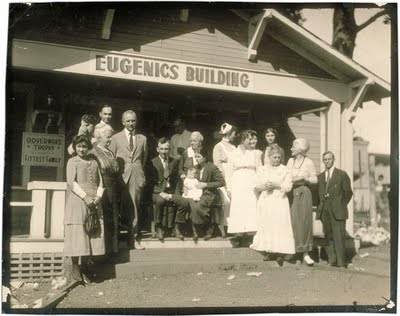The Search for ‘Biologically Superior’ People Brings Ludicrous (and Dangerous) Results
 In the 1920s, pigs, sheep, and other farm animals weren’t the only creatures bringing home blue ribbons from the fair. So were humans.
In the 1920s, pigs, sheep, and other farm animals weren’t the only creatures bringing home blue ribbons from the fair. So were humans.
Starting at the Kansas Free Fair, people competed in Fitter Families contests, where doctors examined family members for physical and psychological health. Well-bred humans went home with a trophy and the honor of being declared a “Grade A Individual” As one contest brochure explained, “The time has come when the science of human husbandry must be developed based on the principles now followed by scientific agriculture, if the better elements of our civilization are to dominate or even survive.”
This is not fiction. It may sound like something that happened somewhere over the rainbow, but it actually happened in Kansas–and elsewhere.
Fitter Families contests were just one of more bizarre outgrowths of the eugenics movement, which was committed to improving humanity through selective breeding. In Britain, eugenicists even suggested giving “eugenic stripes” to “biologically superior” men who fought in World War I. Eugenicists were afraid that women would not be willing to mate with superior men who received unattractive scars in battle. The idea was for these men to wear eugenic stripes on their uniforms, indicating they were biologically superior and enticing women to overlook their injuries, says Daniel Kevles’ book on the history of eugenics, In the Name of Eugenics (Harvard University Press).
Eugenics became quite fashionable and was endorsed by many prominent people in the early twentieth century. Some of them even argued that to create a more perfect society the control of propagation should be shifted from families to the government. The famous science fiction writer H.G. Wells put it this way: “The children people bring into the world can be no more their private concern entirely, than the disease germs they disseminate or the noises a man makes in a thin-floored flat.”Â

I recently spoke on “The Disappearing Man” at San Diego’s stunning Museum of Man, which featured the exhibit, “RACE: Are We So Different?”
According to Kevles, “Eugenicists of every stripe found common ground in the righteous idea of wiping out social defect by preventing the procreation of the eugenically undesirable. Suggestions to reach that end ran the gamut from the cruel (putting degenerates painlessly to death or permitting mothers to smother children possessing inherited deformities) to the mocking (the abolition of alcoholism by letting the intemperate drink themselves to death or the punishment of a murderer by hanging his grandfather).”
You can get a taste of the history behind the eugenics movement in the traveling exhibit, “RACE: Are We So Different?” I had the honor of doing a book signing for The Disappearing Man a week ago amidst this exhibit at the Museum of Man in San Diego. If you want to check out the exhibit online take a look at: http://www.understandingrace.org/home.html
Kevles’Â In the Name of Eugenics points out that the founder of the eugenics movement, Francis Galton, thought he could use biology to eliminate original sin. “He found in eugenics a scientific substitute for church orthodoxies, a secular faith, a defensible religious obligation.”
As it turned out, eugenics became forever linked to Adolf Hitler’s quest for creating a perfect race. So much for eliminating original sin.
By Doug Peterson
